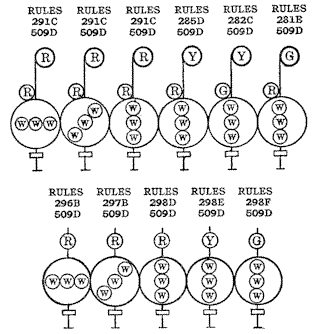10
HOURS DURING WHICH DAY OR NIGHT TRAIN ORDER AND BLOCK OFFICES ARE IN OPERATION. | |
Rochester | 8:30 A. M. to 12:00 Noon |
" | 1:00 P. M. to 5:30 P. M. |
" | Sat. & Sun. - Closed |
Industry | 7:00 A. M. to 11:00 A. M. |
" | 11:30 A. M. to 3:30 P. M. |
" | Sat. & Sun. - Closed |
Avon | 7:00 A. M. to 11:00 A. M. |
" | 12:01 P. M. to 4:00 P. M. |
" | Sun. - Closed |
Livonia | 6:00 A. M. to 11:00 A. M. |
" | 12:01 P. M. to 3:00 P. M. |
" | Sat. & Sun. - Closed |
Wayland | 6:15 A. M. to 11:15 A. M. |
" | 12:15 P. M. to 3:15 P. M. |
" | Sun. - Closed |
Atlanta | 7:00 A. M. to 11:00 A. M. |
" | 12:01 P. M. to 4:00 P. M. |
" | Sat. & Sun. - Closed |
Cohocton | 7:00 A. M. to 11:00 A. M. |
" | 12:01 P. M. to 4:00 P. M. |
" | Sat. & Sun. - Closed |
Avoca | 7:00 A. M. to 11:00 A. M. |
" | 12:01 P. M. to 4:00 P. M. |
" | Sat. & Sun. - Closed |
Kanona | 6:30 A. M. to 2:30 P. M. |
" | Sat. & Sun. - Closed |
Bath | 7:00 A. M. to 12:00 Noon |
" | 1:00 P. M. to 4:00 P. M. |
" | Sat. & Sun. - Closed |
Savona | 6:30 A. M. to 10:00 A. M. |
" | Sat. & Sun. - Closed |
Campbell | 11:00 A. M. to 3:30 P. M. |
" | Sat. & Sun. - Closed |
Caledonia | 8:00 A. M. to 11:00 A. M. |
" | 12:01 P. M. to 5:00 P. M. |
" | Sat. & Sun. - Closed |
Batavia | 9:00 A. M. to 11:00 A. M. |
" | 12:01 P. M. to 4:00 P. M. |
" | Sat. & Sun. - Closed |
|
|
Day or Night Train Order and Block Offices are specified as opening and closing at certain times, but it is frequently necessary to have them open at hours before or after the time specified for operation, and trains will be governed by the signals at such points regardless of time specified for operation. | |
All trains entering a block under permissive signal indication displayed at a Day and Night Block Signal Office will run under permissive signal indication to the next Day and Night Block Signal Office regardless of a clear signal that may be displayed at intermediate Day or Night Block Signal Office, except when enginemen have positive information that the Day or Night Block Signal Office is actually in operation. If a stop signal | |
is displayed trains will stop and ascertain cause. |
|
POSITION LIGHT TELEPHONE TRAIN ORDER SIGNAL |
A position light unit attached to pole below upper unit. |
 |
When position light telephone train order signals are in service Rules 509b, 509c and 509d will be observed the same as where other types of signals are in use. |
|
RATING FOR ORDINARY TRAINS. |
Train tonnage will be determined by the Chief Train Dispatcher. Trains will be given maximum rating unless otherwise directed. |
|
RULE 33 OF "RULES FOR THE OPERATION AND SUPERVISION OF AIR BRAKE, TRAIN AIR SIGNAL, STEAM HEAT EQUIPMENT AND CAR LIGHTING SYSTEMS, EFFECTIVE, JAN. 1, 1943," AND AMENDMENTS THERETO: |
Passenger trains will make running test of air brakes before descending grades at following points: |
EASTWARD. At M.P. 395, East of Griswolds, if train does not stop at station. |
At M.P. 364, east of Castile, if train does not stop at station. |
WESTWARD. At M.P. 387 west of Linden, if train does not stop at station. |
|
MISCELLANEOUS |
Diesel engines, Motor Cars and Roller Bearing equipped freight and passenger cars must not be operated in water that is higher than underside of ball of rail. |
"Employes must observe passing trains, and if any hot journals, defective brakes, defective running gear, flat wheels, etc., are observed, trainmen will be notified by use of following code: |
HOT JOURNALS. |
By day - Hold nose with first finger and thumb of right hand and point down toward track with left hand. |
By night - Hold lantern in hand by the guard wires around the globe and swing in small vertical circle. |